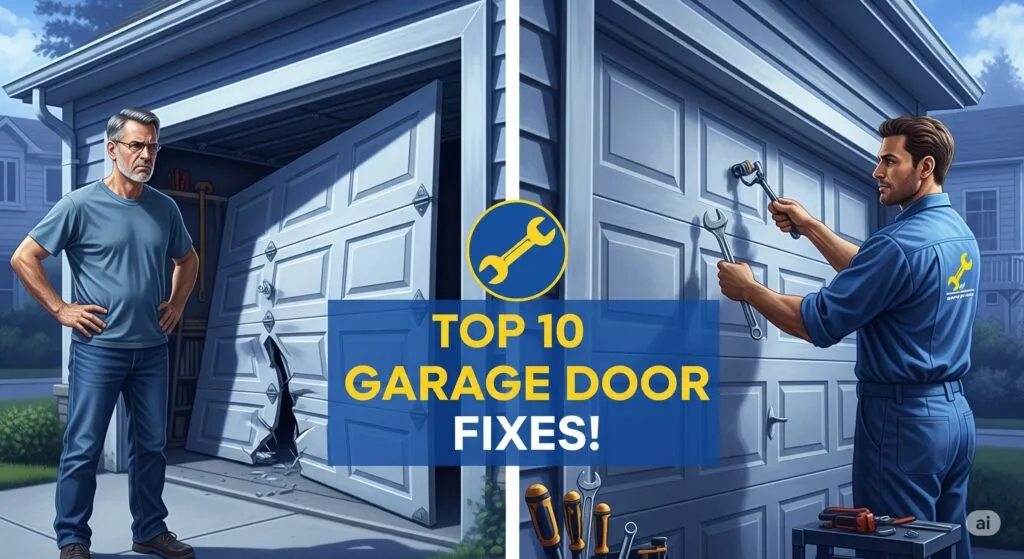Introduction to Garage Door Repair

Garage doors are essential to your home’s security, convenience, and curb appeal. When something goes wrong, it can be frustrating—and even dangerous. Whether your garage door is stuck halfway, making strange noises, or not responding at all, timely garage door repair can save you money, time, and stress.
This guide offers the top 10 practical solutions for fixing the most common garage door issues. From squeaky rollers to faulty sensors, you’ll find expert tips to get your door back on track.
Common Signs Your Garage Door Needs Repair
It’s important to know the early warning signs that your garage door needs attention. Ignoring small issues can lead to expensive fixes later.
Noisy Garage Door
If your garage door sounds like a haunted house, that’s a red flag. Grinding, squealing, or rattling noises usually mean parts need lubrication or replacement.
Door Won’t Open or Close Completely
Your garage door may stop mid-cycle, open only halfway, or refuse to budge at all. This could be due to sensor misalignment, broken springs, or an opener malfunction.
Essential Tools for DIY Garage Door Repair
Before diving into repairs, make sure you have these handy tools:
- Adjustable wrench
- Flathead and Phillips screwdrivers
- Locking pliers
- Cordless drill
- Garage door lubricant (not WD-40)
- Safety glasses
- Stepladder
Safety Tips Before Starting Repairs
Garage doors are heavy, tension-loaded systems. Follow these precautions:
- Unplug the opener before starting.
- Wear protective gloves and glasses.
- Don’t attempt to remove or replace torsion springs without training.
- Use C-clamps to secure the door in place.
Top 10 Garage Door Repair Solutions
1. Fixing a Broken Garage Door Spring
Springs bear the brunt of lifting your garage door. If your door feels heavy or won’t open, a broken spring could be the culprit.
DIY Tip:
Torsion springs should only be replaced by professionals due to the risk of injury. Extension springs, on the other hand, can sometimes be swapped safely with the right tools and know-how.
2. Replacing Worn-Out Rollers
Old or cracked rollers create loud grinding noises and hinder smooth operation.
Fix:
Use a wrench to loosen the roller brackets, slide out the worn rollers, and pop in the new ones. Be sure to lubricate them afterward.
3. Realigning the Garage Door Sensors
Photo-eye sensors prevent the door from closing on objects. If the door reverses unexpectedly, your sensors might be dirty or misaligned.
Fix:
Clean the lenses with a soft cloth and ensure both sensors face each other at the same height.
4. Lubricating Hinges, Springs, and Tracks
A squeaky garage door is often a dry garage door. Proper lubrication reduces wear and extends the life of components.
Best Lubricant:
Use a silicone-based spray or white lithium grease—never use WD-40, as it removes lubrication.
5. Tightening Loose Hardware
Vibrations from daily use can loosen brackets, bolts, and nuts.
What to Do:
Go over all visible parts with a wrench or socket set, especially the track brackets and roller supports.
6. Adjusting the Garage Door Opener Settings
If your door opens or closes too far, it might slam or not shut all the way.
Adjustment Tip:
Find the limit screws on the opener unit and fine-tune them to control how far the door travels.
7. Repairing Bent Tracks
A bent track can throw your entire door off balance.
Solution:
Use pliers or a rubber mallet to gently straighten the track. For severe bends, replacement is best.
8. Resetting the Garage Door Opener
A simple reset can solve many opener glitches.
Reset Process:
Unplug the unit, wait 30 seconds, and plug it back in. Re-sync your remote or keypad if needed.
9. Weatherstripping Replacement
Worn weather seals let in water, dirt, and pests.
Fix:
Remove the old strip and slide in a new one from your local hardware store. Trim to fit.
10. Diagnosing Electrical Issues
If your opener doesn’t respond, check the power supply, circuit breaker, or wall switch.
Tip:
Try plugging in another device to the same outlet to rule out electrical problems.
When to Call a Professional
Not all garage door issues are DIY-friendly. Call a licensed technician if you:
- Hear loud snapping or popping sounds
- See frayed cables or broken springs
- Suspect motor or circuit board failure
- Need full system replacement
Cost of Garage Door Repairs
Here’s a quick breakdown of typical costs:
| Repair Type | Average Cost (USD) |
|---|---|
| Spring Replacement | $150 – $350 |
| Cable Replacement | $100 – $200 |
| Roller Replacement | $90 – $150 |
| Opener Repair/Replacement | $100 – $500+ |
| Track Adjustment | $125 – $200 |
Preventive Maintenance Tips
To avoid future headaches:
- Inspect hardware monthly
- Lubricate moving parts quarterly
- Test auto-reverse safety features
- Clean photo-eye sensors regularly
FAQs About Garage Door Repair
1. How long do garage door springs last?
Typically 7–9 years or around 10,000 cycles (open and close).
2. Can I fix a garage door spring myself?
It’s strongly advised to hire a pro for torsion springs. They are under high tension and can be dangerous.
3. Why does my garage door open randomly?
This could be a wiring short, radio interference, or faulty remote. Try resetting the opener or reprogramming remotes.
4. How often should I lubricate my garage door?
Every 3 to 6 months, especially before winter.
5. Should I replace both springs if only one is broken?
Yes, replacing both ensures balanced operation and even wear.
6. What if my garage door is off-track?
Stop using the door immediately and call a technician. Forcing it can damage the track and rollers.

